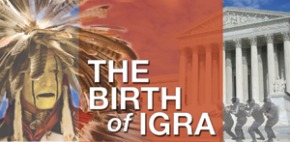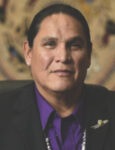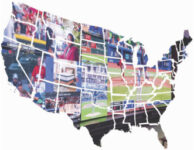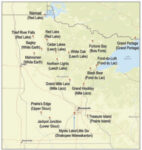
In the 1980s, the United States Congress didn’t want to consider a bill that legalized the rapidly growing business of Indian gaming, but it had no choice. While Congress was concerned with the spread of Indian gaming, it was content for the most part to leave its control to the states and/or the courts.
But when the Supreme Court ruled on the Cabazon case in 1987, Congress came under increasing pressure from the states to define Indian gaming and how the states could control its expansion. This pressure was the catalyst to the birth of the Indian Gaming Regulatory Act of 1988.
There were many major players on the road to IGRA: senators, congressmen, governors, tribal chairmen and chairwomen… But the real work, as usual, was performed in the trenches by staff members, advisers and attorneys. These are stories from three of the less-celebrated participants in the Cabazon case and the negotiations that led to the final version of IGRA. And as with most good pieces of legislation, no one was fully satisfied with the final project, but no one can deny it has worked effectively for the last 25 years, since it was passed in 1988.
Glenn Feldman was a young lawyer in the mid-1980s who represented the 25 members of the Cabazon tribe. In order to supplement their dirt-poor existence, the Cabazons had opened up a poker room in the fall of 1980 on their reservation in the Southern California desert, just like the poker rooms operated by other Californians just down the road. When two days later Indio police and later Riverside County deputies raided the casino in full SWAT regalia, Feldman defended the Cabazons all the way to the Supreme Court. Today, Feldman is a partner with Dickenson Wright in Phoenix.
Henry Buffalo was the in-house attorney for the Fond du Lac Band of Lake Superior Chippewa. His boss was Chairman Bill Houle, who tapped him to represent the tribe in gaming because he had already been doing work on natural resources on the tribe’s reservation. Buffalo today is a shareholder in the firm of Jacobson Buffalo Magnuson Anderson & Hogen, P.C., in Minneapolis.
Patricia Zell was the staff director and chief counsel for the Senate Indian Affairs Committee from 1987 through 2005, when Senator Daniel Inouye (D-Hawaii) was chairman, and was known to be very friendly to causes of Native American tribes. Zell was closely involved with the IGRA negotiations, trying to bring all the diverse views together to craft a bill that would pass Congress quickly. Today, she is a partner at Zell & Cox Law, P.C. in Alexandria, Virginia.
Cabazon Creation
Feldman traces the timeline from the raids on the Cabazon poker room until the Supreme Court decision.
“We had filed lawsuits in several courts the first two years, gotten some favorable and other not-so-favorable rulings, and when the Riverside deputies raided, we had to start over again. But when the state of California intervened in 1983, it became really serious. It had been just the tribe against the local authorities, but now the state was involved.
“So then, we’re back in the District Court against the county and the state. In December of ’84, the District Court ruled in our favor. In February of ’86, the Ninth Circuit affirms. Then they appeal to the U.S. Supreme Court, asking the court to review the case, and in June of ’86 the Supreme Court agrees to hear the case. In December of ’86, we argue the case before the Supreme Court, and in February of ’87, the court issues its ruling. So it takes a full seven years to get there.”
Zell says even before the Cabazon decision, Congress was concerned and looking at ways to define federal oversight of gaming on Indian lands. It was the Cabazon case that crystalized the need for federal legislation, Zell said. But once the case reached the Supreme Court, all progress toward a federal bill halted.
“The Cabazons thought they had a solid wall of law behind them, but nobody knew for sure,” says Zell. “And that made the negotiations certainly interesting, probably more precarious, and made it hard for either side to exercise the sole amount of brinksmanship, because nobody knew where the ultimate power lay.”
Long before, Buffalo says tribes had been asking the Indian Affairs section of the Interior Department (BIA) to help them protect their bingo halls and poker rooms.
“One of the responses from the bureau was to establish a gaming or bingo commission, as it was known. And it selected several tribal leaders, and Bill Houle was one of those who was selected. He had me participate with him on that. The commission met for about a year or two, and visited many reservations. At the conclusion of the hearings, their report back to the bureau was that bingo was being conducted without regulations. And that was in ’85 or ’86, when the proposals in Congress were all anti-Indian gaming, either wipe it out or put it under state control.”
One of the meetings was at the Eden Roc hotel in Miami, where racetrack operators were also holding a conference at the Fontainebleau. Buffalo remembers visiting the hotel and seeing a huge ice sculpture of a thoroughbred racehorse.
“That was an eye-opener for us,” he explains. “We knew at that point that the thoroughbred guys, the dog track guys, and the commercial gaming guys and the state governments were all against us. So, the next day at the meeting, we encouraged the tribes to call for a national meeting to create a new organization, that would be the catalyst of any legislation going forward.”
Difficult Negotiations
The Cabazon decision was the watershed moment that spurred Congress to act.
“So the court rules in favor of the tribes, and the floodgates open,” says Feldman. “Everyone in Congress agrees. ‘Now we’ve got to do something.’ The court had given the tribes pretty much carte blanche here, so Congress felt it needed to step in and do something. And so from early ’87 until the fall of ’88, there’s a lot of bills introduced, a lot of hearings held, a lot of negotiations taking place. And finally, the legislative sausage factory came up with what came to be the Indian Gaming Regulatory Act in the fall of ’88.”
Zell says there were senators on both sides of the issue, but few had much knowledge of the gaming industry. So the Senate Indian Affairs Committee took road trips to Nevada and New Jersey to examine their regulatory systems.
“(Nevada) Senator Harry Reid certainly kept up the drumbeat of his concerns about the potential for infiltration of organized, or unorganized crime, for that matter, and so we—Senator Inouye and his staff—spent a few days in Nevada, meeting with regulators and others, and really learned their system very well.”
When Inouye’s counterpart John McCain came back with a similar experience, there was a consensus that a regulatory system was necessary. But the extent of that system was hotly debated.
“The tribes, having won the Cabazon victory, were very adamant that they didn’t need to be regulated and to the extent there needed to be regulation, they could do it themselves,” says Zell. “But no one could dream that Indian gaming would become what it is today. We didn’t have crystal balls, and still don’t, and so the idea that Indian gaming would become what it has become was far, far from our imagination. No one could anticipate—at least not in the public service sector—the proliferation that gaming technology would enable.”
But there was a problem. The Reagan administration was in office and resisted the implementation of any additional federal regulations.
“John Bolton, who was then a deputy attorney general in the Justice Department, told us there could be no federal presence in a national regulatory system should there be one, and Reagan would veto any bill that has any federal presence in Indian gaming,” Buffalo says. “And states wanted to be able to regulate Indian gaming themselves.”
But there was a flaw in that argument because in some states where Indian gaming would flourish, there was no state regulatory apparatus.
“We had some very, very helpful dialogues with the National Governors Association, with individual governors, with attorneys general, and that really helped to be able to identify where there needed to be much more oversight and focus. Even though the National Indian Gaming commission was not given authorization to have a role in Class III gaming, it certainly was a mechanism by which one could, through a commission, begin to address how to enhance state systems and how to enhance the cooperative relationships between states and tribes. In some cases, the tribes had been in gaming long enough, and they knew more than the states.”
Buffalo’s meeting led to the creation of the National Indian Gaming Association, and the tribes sat down to craft a series of demands that would be included in any bill. As the organization grew, it signed up members from all over the country.
“At first, we just thought we were going to be dealing with bingo,” Buffalo says. “But the Shakopee in Minnesota had Class II gaming machines, and we lobbied pretty hard to protect those machines, to grandfather them in. Later, they decided to broaden the gaming activities. Not only Class II, but then they created Class I and Class III—the traditional games, the bingo games, and also casino games, or Class III games.”
NIGA became the driving force behind IGRA, working late into the night and on weekends to outline a bill that would work for tribes, but also satisfy the members of Congress who needed to show a certain “control” over Indian gaming. The result was the formation of the National Indian Gaming Commission.
“After the bill was passed, the first thing that had to be done was the adoption of regulations to implement the bill that would govern the National Indian Gaming Commission,” Buffalo says. “I participated in the task force that was set up through the National Indian Gaming Association, under the leadership of Rick Hill. The task was to assist the federal government, or Interior in drafting the regulations that would implement the act.”
Feldman says the addition of Class III games to the IGRA draft created a confusion that continues to this day.
“It’s a function of the ambiguity in IGRA,” he says. “There were hard-fought views on both sides of this issue, and so the bill that was passed in ’88 was a compromise, and the one way that you sometimes get compromise in legislation is to put in language that everybody can read their own way. That’s exactly what happened in IGRA.
“For Class III games, this ambiguity lasted until 2005, when the Colorado River Indian Tribes won a case that determined that states, not the NIGC, can regulate Class III Indian gaming.”
IGRA Initiation
Buffalo says that negotiations during the crafting of IGRA could only go so far. Congress would push back at tribal demands, and there were several impasses.
“The evolution of the language of the bill ultimately resulted in the majority of tribes saying, ‘Well, let’s go with it; it’s probably the best that we have right now, but at least it will be protected—by both a Supreme Court decision and legislation.’ So the tribes thought it important to have a neutral party adjudicate disputes between tribes and states. And that’s what the states fought over the most, too. But tribes absolutely felt it was necessary to have a neutral party address any disputes that would arise out of the negotiation of compacts.”
Zell says that as the states pushed to be the regulator over Indian gaming, the tribes began to lessen their resistance to federal oversight.
“There seemed to be some convergence in this area, and there were very few areas were there was convergence,” she says. “So the tribes, if they had to be regulated, preferred the federal government, and the states said, ‘that’s fine with us, because we don’t really want the feds looking down over our shoulders and telling us how well or not we are regulating.’”
Another problem, says Zell, is that tribes often couldn’t offer their input in the 1980s.
“Before gaming, most tribes didn’t have the wherewithal to send one or more leaders to Washington. They had to have bake sales, they had to raise money in every possible way to buy an airline ticket to send one member of the tribe to Washington. So the tribes were really disadvantages because they couldn’t be at the table in the same way that the states could be at the table.”
Buffalo says there where things that tribes did want controlled, however.
“A big concern was those early management contracts that tribes were signing where the tribes were getting 20 percent and the managers were getting 80 percent. They were just awful arrangements. That was a critical, important piece to the tribes. So the tribes were really interested in getting that language into the policy—that the tribe should be the primary beneficiary and were the sole proprietors of the gaming businesses.”
Limiting participation to tribal governments was also a point of contention.
“Some tribes from the Northwest had, up to that point, a history of individual tribal members operating gaming facilities on the reservations,” says Buffalo. “They argued within NIGA that was part of the history from their region of supporting individual business on reservations and they wanted to protect that somehow.But those operations really flew in the face of what everybody else was doing around the country, which was the tribal governments operating them, either with managers or by themselves, but not owned by an individual. What NIGA was saying was that Indian gaming was all about governmental gaming, no different than those activities that each of the states were authorized through their lotteries, and/or their charitable activities, and/or their authorization of commercial gaming. That point eventually won the day.”
Zell says tribal government gaming was one of the most important developments ever experienced in Indian Country.
“There weren’t many businesses in those days that tribes could get into that would be profitable, and certainly not the way gaming has become profitable,” she says. “So there were quite a few things that came to pass, that we couldn’t have foreseen, and most of it worked for tribes all over the country.”

















